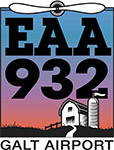The Galt RNAV-B approach procedure is a non-WAAS GPS approach, with no vertical guidance and although the approach is perfectly aligned with runway 27 it has only circling minimums (the reason for this was discussed in an earlier blog post). The circling minimum descent altitude (MDA) is 1,480 feet MSL, or 605 feet height above touchdown (HAT), and the minimum visibility requirement is 1 statute mile (SM).
Because cloud ceilings are reported in hundreds of feet, the lowest legal report ceiling for this approach would be 700 feet.
There is no visual descent point (VDP) on this procedure (VDPs are only depicted on straight in non-precision approaches). This means the pilot must determine their own VDP from where they can make a stabilized straight in approach from the MDA to a landing, using normal maneuvers and a normal descent rate, per FAR §91.175(c).
For most GA aircraft a normal descent rate would be close to a 3° flight path to the runway and on this approach that would intersect the MDA at 1.9 NM from the runway threshold1. But before you can descend below the MDA you must be able to identify at least one of the approved visual references for the runway (i.e. the runway environment). If the visibility is only 1 mile you will not be able to do that from 2 miles away.
This suggests that a stabilized straight in landing from this approach procedure is not feasible in minimum visibility conditions, but there is another option.
The procedure allows for a level off at the MDA, continue flying to the missed approach point (MAP), then circle back to runway 27 by flying the full pattern—upwind, crosswind, downwind, base and final. During the circling procedure the pilot must remain within sight of the runway at all times and may descend below the MDA when they are in a position to make a normal landing, i.e. abeam their touchdown point.
However, sometimes what might be legal is not always smart. Circling at minimums in IMC (or at night) requires an exceptional level of skill and proficiency and there are multiple risks. First, because a normal traffic pattern downwind distance from the runway is about 1 NM, it would be very likely you would lose sight of the runway at some point during this maneuver. Second, the circling minimums are already 200 feet lower than the usual 800 feet AGL traffic pattern altitude at Galt and you would not want to risk any other abnormal landing procedure such as flying a tighter pattern and creating an unstable approach.
If conditions are indeed at minimums for this airport it would be wiser to wait until the visibility improved to at least 2 SM or pick an alternate airport such as Waukegan, which has multiple options for approaches with vertical guidance.
Beth Rehm, CFII
Note 1. A pilot can estimate a VDP for any RNAV approach by by dividing the height above touchdown (HAT) by 318 feet.

